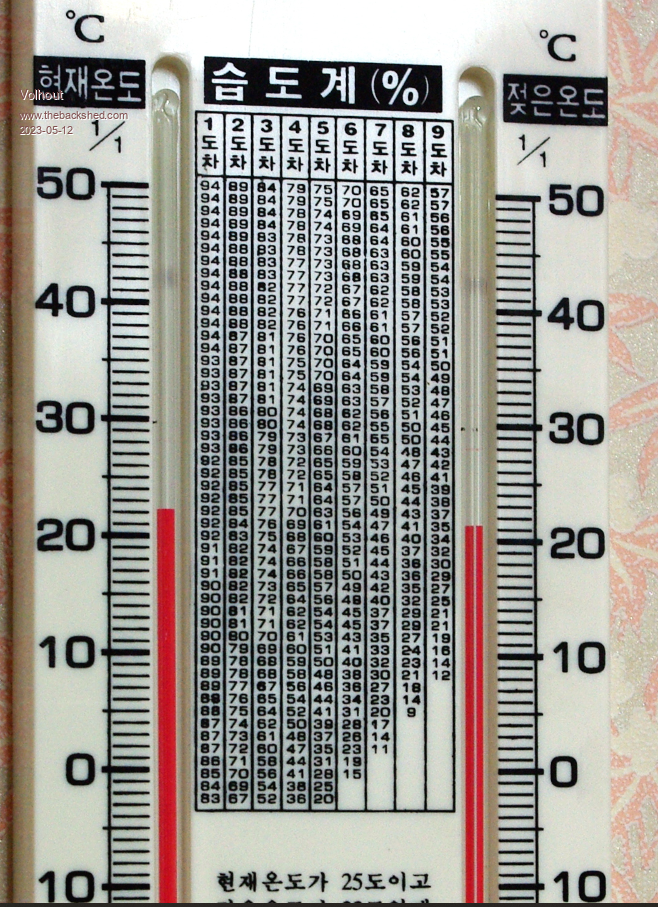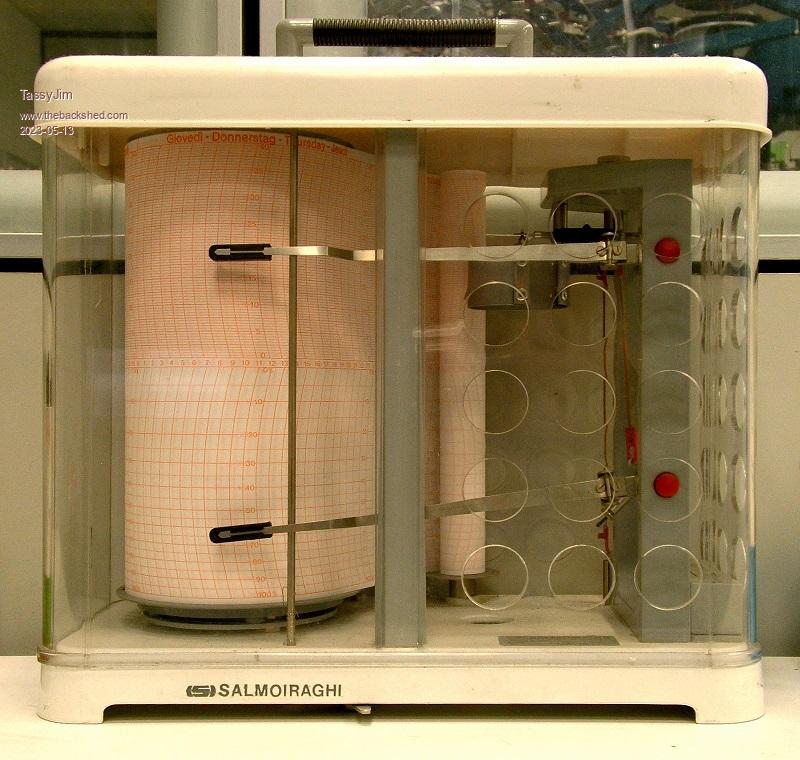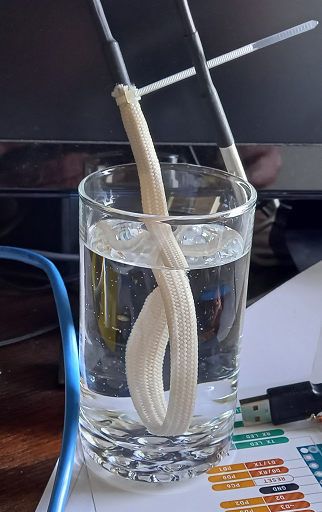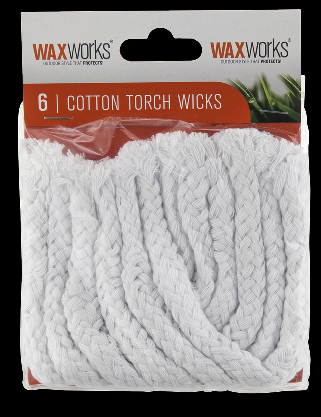
|

|
Forum Index : Microcontroller and PC projects : Question: humidity sensor for tropical forest habitat
| Page 1 of 2 |
|||||
| Author | Message | ||||
| Volhout Guru Joined: 05/03/2018 Location: NetherlandsPosts: 4250 |
My son has a habitat for small frogs, an environment that is very humid and temperatures around 30 degrees C. I was looking into monitoring the humidity in that habitat, but have not found a practical solution yet. The DTH11/DTH22 sensors as well as many of the silicon solutions are all based on polymer films, and if you read all datasheets carefully, all have remarks that prolongued operation at 95% relative humidity or more will degrade the sensor, and recovery in dry environments is needed to revive them. This seems more or less standard for all polymer based solutions. The only information I found so far for a solution that will work reliably long term is the thermal conductivity absolute humidity sensor. Does anyone here have experience with that type of sensor, and could point me to a sensor that would be suitible for this application ? I know there are sensors of this type in earlier laundry dryers, but recent dryers measure humidity by measuring the conductivity of the wet laundry. Any help is appreciated... Volhout PicomiteVGA PETSCII ROBOTS |
||||
TassyJim Guru Joined: 07/08/2011 Location: AustraliaPosts: 6101 |
The old way to measure humidity was to have a wet bulb and a dry bulb thermometer. The wet bulb is a standard thermometer with a wick around it and fed from a bottle of water. You then look up the tables to find humidity. Plenty of calculators on the net. I haven't tried it with DS18B20s yet, but I will one day. It should be an interesting experiment. I replace my DHT22 every 2 years. Jim Edited 2023-05-12 19:50 by TassyJim VK7JH MMedit MMBasic Help |
||||
Quazee137 Guru Joined: 07/08/2016 Location: United StatesPosts: 572 |
A few odd thoughts 1st rotate between two using a servo. 2nd add a heater resistor to back of sensor and when you detect it is degraded heat it up. HR202 Humidity Sensor.pdf Had a site where they only sent out a tech every week and conductivity probe would foul before he'd get there. So rotated bad one out good one in. or rotate sensor into a bin of silica gel beads. Quazee137 |
||||
| Volhout Guru Joined: 05/03/2018 Location: NetherlandsPosts: 4250 |
Looked at Wiki, found a picture that shows a physical device. My chineese is sub zero, but I think that the tables columns indicate the temperature difference and a certain level of the dry bulb (the wet bulb would normally not exceed 35C since humans would die, and there would be no-one to read the temperature).  This would require pretty accurate temperature measurement and calibration. I'll play a bit with the idea. The good thing is that the wet bulb is easy to achieve since there are water pools in the habitat... Volhout Edited 2023-05-12 21:13 by Volhout PicomiteVGA PETSCII ROBOTS |
||||
| Volhout Guru Joined: 05/03/2018 Location: NetherlandsPosts: 4250 |
The sensor has max 95% RH. But I will think about the idea of rotating out sensors weekly (servo or other). Heating makes things worse (heat and humidity combined make the poly sensors age faster, good thing the habitat is only 30 degrees). Thank you for suggesting... Volhout Edited 2023-05-12 21:20 by Volhout PicomiteVGA PETSCII ROBOTS |
||||
| Volhout Guru Joined: 05/03/2018 Location: NetherlandsPosts: 4250 |
Quazee, Jim, One thing to add, the habitat moisure level is caused by regular generation of fog (water vapor). So there are moments when relative humidity (RH) exceeds 100%. I realy like the idea of the wet bulb/dry bulb system. It matches with the application a lot. Volhout PicomiteVGA PETSCII ROBOTS |
||||
Quazee137 Guru Joined: 07/08/2016 Location: United StatesPosts: 572 |
what about trying Fieldpiece ATWB1 K-Type Wet Bulb Thermocouple and a dry K-type. A way to get the data electrically. Will need a bit of math but we do have that with MMBasic. Quazee137 I wasn't thinking about the newer sensor types but a few probes I've used that heating them helped them last longer. |
||||
| Volhout Guru Joined: 05/03/2018 Location: NetherlandsPosts: 4250 |
I'll look into the ATWB1-K, that is a complete solution. And I have one of those thermocoule amplifier boards. I was triggered by the idea of using DS18B20's. I have 2 of these sensors (metal tubes with sealed cable). I could put 1 in a (wet) wick, the other adjacent to it and do the math. Will try this first, since I have them on hand.. Volhout P.S. I was original planning on using a DHT22 since I wanted to read temp and humid. Now I use 2 temp sensors and have both also... PicomiteVGA PETSCII ROBOTS |
||||
| JanVolk Senior Member Joined: 28/01/2023 Location: NetherlandsPosts: 145 |
That Chinese table is the Mollier diagram to determine the humidity manually. The two temperatures are measured with a ptc or ntc sensor. In the greenhouses in my area (West of the Netherlands), measurement with dry/wet bulb is still used today, but due to regular maintenance, this is increasingly done with an electronic sensor. The electronic versions have the disadvantage that they need to be calibrated, so it is more economical in practice to renew the entire sensor. Two watertight DS18b20 sensors would work well and include the table in the microcontroller or by means of a formula. Do use good cotton stockings and a small auxiliary fan and demineralized water because the table is based on this. The DTH22 or DTH11 is not really suitable and I have the DHT20 which according to the specifications should work better and also have the correct i2c subroutine for this sensor but have not yet tested it in practice at a location. Nice day. |
||||
TassyJim Guru Joined: 07/08/2011 Location: AustraliaPosts: 6101 |
50 years ago I used thermo-hydrographs to record temperature and humidity. The humidity pointer was controlled by a length of (usually) human hair. I no longer have a supply of human hair to experiment with.  The drum was clockwork and the charts could be 24 hour or 7 days per revolution. Jim Edited 2023-05-13 10:45 by TassyJim VK7JH MMedit MMBasic Help |
||||
TassyJim Guru Joined: 07/08/2011 Location: AustraliaPosts: 6101 |
Two options. First with just Wet and Dry bulb and the second with Atmospheric pressure. ' formula for getting Rel Humidity given Wet and Dry bulb temperature ' TassyJim May 2023 OPTION EXPLICIT OPTION DEFAULT FLOAT DIM Ed ' Saturation Vapour Pressure (millibars) at dry bulb temp DIM Ew ' Saturation Vapour Pressure at Wet Temp in millibars DIM Rh ' relative humudity DIM Td = 20 ' dry bulb DIM Tw = 15 ' wet bulb DIM At = 1000 ' atmospheric pressure used in formula 2 DIM e = 2.7182818245904 DIM N = 0.6687451584 DIM N2 = N/1000 ' used in option 2 Ed = 6.112*e^((17.502*Td)/(240.97+Td)) Ew = 6.112*e^((17.502*Tw)/(240.97+Tw)) Rh = (Ew-N*(1+0.00115*Tw)*(Td-Tw))/Ed*100 PRINT Ed, Ew, Rh Ed = 6.112*e^((17.67*Td)/(243.5+Td)) Ew = 6.112*e^((17.67*Tw)/(243.5+Tw)) Rh = (Ew-N2*(1+0.00115*Tw)*(Td-Tw)*At)/Ed*100 PRINT Ed, Ew, Rh I am sure that if I look further, there will be many more variations on the net.  This uses a bootlace as the wick. Not the best choice but my wife's sewing basket didn't have anything better. On my desk without any air movement, it reads about 10% higher than a DHT22 With a bit of breeze, it would come down nicely. Jim Edited 2023-05-13 15:36 by TassyJim VK7JH MMedit MMBasic Help |
||||
| PeterB Guru Joined: 05/02/2015 Location: AustraliaPosts: 651 |
Thanks Jim. I have been going to set up a couple of 18B20s but the graph is enough to put me off. The words ENTHALPY & ENTROPY still give me nightmares however, it may be of interest to some. Peter 20230513122210386.pdf |
||||
| phil99 Guru Joined: 11/02/2018 Location: AustraliaPosts: 2140 |
Yes, long ago also had to monitor air-con zones with thermo-hydrographs and a sling psychrometer (with wet and dry bulbs) to calibrate them. This had to be spun at a rate that gave an airspeed of 60km/h for the Rh graph that came with it to be accurate. There was also a correction table that required the barometric pressure for better accuracy. Distilled water was required for best results. |
||||
| Volhout Guru Joined: 05/03/2018 Location: NetherlandsPosts: 4250 |
Hi Jim, ypu beat me to it. This was exactly what I had in mind. I also found these formulas on the web. The breeze is something I jave to work on..m Volhout PicomiteVGA PETSCII ROBOTS |
||||
TassyJim Guru Joined: 07/08/2011 Location: AustraliaPosts: 6101 |
I have added the version that BOM (Australian Gov Bureau of Meteorology) suggests. http://www.bom.gov.au/climate/maps/averages/relative-humidity/files/calc-rh.pdf ' formula for getting Rel Humidity given Wet and Dry bulb temperature ' TassyJim May 2023 OPTION EXPLICIT OPTION DEFAULT FLOAT DIM Ed ' Saturation Vapour Pressure (millibars) at dry bulb temp DIM Ew ' Saturation Vapour Pressure at Wet Temp in millibars DIM Rh ' relative humudity DIM Td = 20 ' dry bulb DIM Tw = 15 ' wet bulb DIM At = 1000 ' atmospheric pressure used in formula 2 DIM e = 2.7182818245904 DIM N = 0.6687451584 DIM N2 = N/1000 ' used in option 2 DIM N3 = 7.866e-4 ' used in option 3 (BOM) Ed = 6.112*e^((17.502*Td)/(240.97+Td)) Ew = 6.112*e^((17.502*Tw)/(240.97+Tw)) Rh = (Ew-N*(1+0.00115*Tw)*(Td-Tw))/Ed*100 PRINT Ed, Ew, Rh Ed = 6.112*e^((17.67*Td)/(243.5+Td)) Ew = 6.112*e^((17.67*Tw)/(243.5+Tw)) Rh = (Ew-N2*(1+0.00115*Tw)*(Td-Tw)*At)/Ed*100 PRINT Ed, Ew, Rh Ed = e^(1.8096+(17.2694*Td)/(237.5+Td)) Ew = e^(1.8096+(17.2694*Tw)/(237.5+Tw)) Rh = (Ew-N3*(1+Tw/610)*(Td-Tw)*At)/Ed*100 PRINT Ed, Ew, Rh The BOM version results in a slightly lower Rh. Jim VK7JH MMedit MMBasic Help |
||||
| zeitfest Guru Joined: 31/07/2019 Location: AustraliaPosts: 482 |
I saw a technique where the RH is found from the "dew point" . A small surface is cooled until water starts to condense on it, and the RH can then be calculated from the temperature vs ambient. The condensation is detected optically and a small Peltier module acts as the cooler. A bit slow and involved though. |
||||
| JanVolk Senior Member Joined: 28/01/2023 Location: NetherlandsPosts: 145 |
This uses a bootlace as the wick. Not the best choice but my wife's sewing basket didn't have anything better. On my desk without any air movement, it reads about 10% higher than a DHT22 With a bit of breeze, it would come down nicely. Are you sure the DHT22 is correct? Mount the sensors horizontally and use rubber grommets to accommodate the two DS18B20. When using a fan at high temperature and high %RH and DC voltage, condensation can occur with a standard fan and thus electrolysis at the connecting wires in the fan, so extra insulation. Make sure the fan is positioned above the sensors and the airflow is upwards. (then the correct temperature and %RH) Also make sure that the bottom of the measuring box is closed off by a filter or gauze and ensure that the water and wick remain clean by preventing the incidence of light and possibly a small drop of bleach in the water to prevent algae growth. Calibration is simple by correcting the correct temperature with an offset and making it exactly equal together and then placing the wick. Suc6. |
||||
| aFox Regular Member Joined: 28/02/2023 Location: GermanyPosts: 76 |
Maybe it is worth to try this one at high levels: i2c-capacitive-moisture-sensor Gregor |
||||
TassyJim Guru Joined: 07/08/2011 Location: AustraliaPosts: 6101 |
Not correct but within a few percent of other sensors I have around the room. It is a long time since I have handled a genuine wick but the bootlace I am using feels too dense. I will find some better material to make a new wick before I get too involved with a fan. Jim  I will try these. Cheap and available at the local hardware store (Bunnings) Edited 2023-05-15 08:13 by TassyJim VK7JH MMedit MMBasic Help |
||||
| Andrew_G Guru Joined: 18/10/2016 Location: AustraliaPosts: 847 |
Gregor et al, Or one of these. Capacitive but fully enclosed (Au$31.45 + postage). I bought one to monitor moisture content under our new house (we have a soil lens that may bring water to the surface). Cheers, Andrew |
||||
| Page 1 of 2 |
|||||